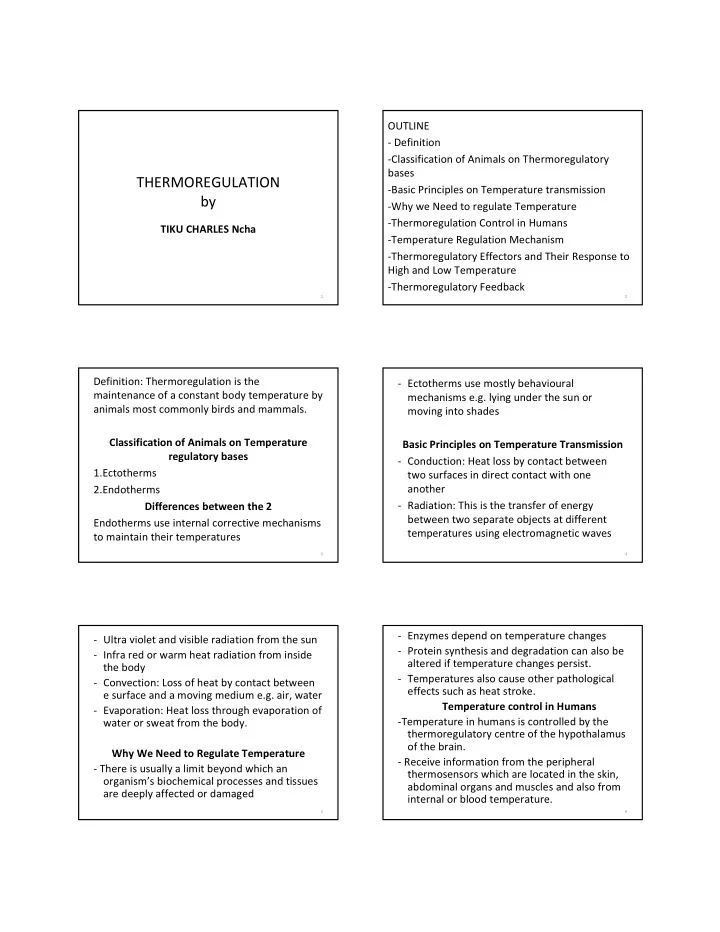

OUTLINE - Definition -Classification of Animals on Thermoregulatory bases THERMOREGULATION -Basic Principles on Temperature transmission by -Why we Need to regulate Temperature -Thermoregulation Control in Humans TIKU CHARLES Ncha -Temperature Regulation Mechanism -Thermoregulatory Effectors and Their Response to High and Low Temperature -Thermoregulatory Feedback 1 2 Definition: Thermoregulation is the - Ectotherms use mostly behavioural maintenance of a constant body temperature by mechanisms e.g. lying under the sun or animals most commonly birds and mammals. moving into shades Classification of Animals on Temperature Basic Principles on Temperature Transmission regulatory bases - Conduction: Heat loss by contact between 1.Ectotherms two surfaces in direct contact with one 2.Endotherms another - Radiation: This is the transfer of energy Differences between the 2 between two separate objects at different Endotherms use internal corrective mechanisms temperatures using electromagnetic waves to maintain their temperatures 3 4 - Enzymes depend on temperature changes - Ultra violet and visible radiation from the sun - Protein synthesis and degradation can also be - Infra red or warm heat radiation from inside altered if temperature changes persist. the body - Temperatures also cause other pathological - Convection: Loss of heat by contact between effects such as heat stroke. e surface and a moving medium e.g. air, water Temperature control in Humans - Evaporation: Heat loss through evaporation of -Temperature in humans is controlled by the water or sweat from the body. thermoregulatory centre of the hypothalamus of the brain. Why We Need to Regulate Temperature - Receive information from the peripheral - There is usually a limit beyond which an thermosensors which are located in the skin, organism’s biochemical processes and tissues abdominal organs and muscles and also from are deeply affected or damaged internal or blood temperature. 5 6
Rise in hypothalamic temperature - Increase muscle tone and shivering -Vasodilation in the skin - Sympathetic activation with secretion of -Reduce muscular tone catecholamines -Looses motivation for physical activities and - Oxidation of fatty acids and glucose reduced clothing - Increase secretion of the thyroid and adrenal -Sweating gland -Reduced activities of the adrenal cortex and - Muscle tone is increased and shivering thyroid gland. triggered A fall in hypothalamic temperature by cooling the shell and core - Cutaneous vasoconstriction 7 8 DYNAMIC GAIN AND SET POINT CONTROL - Dynamic gain systems respond continuously to feedback signals 9 10 Set point systems -Do not respond to a temperature rise before set point is reached. -Caudal hypothalamus works as a thermostat -When temperature rises above the required set point such as 37 0 c effectors turn on and compensatory heat loss is almost linear. -When temperature falls below the set point, compensatory mechanisms are relatively inactive 11 12
Temperature regulatory mechanisms Human thermo-control system - Dynamic and set point characteristics -Implies widespread cutaneous and deep sensors -Their effect converge towards the hypothalamic integrator which acts as a thermostat -Inhibitory neurones perform crossing inhibition diagram. 13 14 - Shivering is released from cutaneous cold sensors - Cold shell activates deep cold sensors in the preoptic hypothalamus - Preoptic thermostat simultaneously reduces Thermoregulatory Effectors and Their Response heat loss by crossing inhibition to High and Low temperature Table. - Sweat is released by preoptic warm sensors as soon as their temperature is 37 0 c or above set point temperature. - In conclusion, preoptic warm sensors show set point characteristics below the set point and cold sensors show set point characteristics above the set point. 15 16 Effector Response to low Response to high Erector pili muscles in skin Muscles contract, raising Muscles relax, lowering the temperature temperature (attached to skin hairs) skin hairs and trapping an skin hairs and allowing air to Smooth muscles in arterioles in Muscles contract causing Muscles relax causing insulating layer of still, circulate over the skin, the skin vasoconstriction. Less heat is vasodilation. More heat is carried warm air next to the skin. encouraging convection and carried from the core to the from the core to the surface, Not very effective in evaporation. surface of the body, maintaining where it is lost by convection and humans, just causing “goose core temperature. Extremities radiation(conduction is generally bumps”. can turn blue and feel cold and low, except when in water). Skin can even be damaged (frostbite). turns red. No sweat produced. Glands secrete sweat onto Skeletal muscles No shivering. Sweat glands surface of skin, where it Shivering: Muscles contract evaporates. Since water has a and relax repeatedly, high latent heat of evaporation, it generating heat by friction takes heat from the body. High and from metabolic humidity, and tight clothing made reactions (respiration is only of man-made fibres reduce the 40% efficient: 60% of ability of the sweat to evaporate increased respiration thus and so make us uncomfortable in generates heat). hot weather. Transpiration from trees has a dramatic cooling effect on the 18 surrounding air temperature. 17
Adrenal and thyroid glands Glands secrete adrenaline Glands stop secreting Thermoregulatory Feed back and thyroxine respectively, adrenaline and thyroxine. which increases the metabolic rate in different tissues, especially the liver, so generating heat. Behaviour Curling up, huddling, finding Stretching out, finding shade, shelter, putting on more swimming, removing clothes. clothes. 19 20 - Cholinergic sympathetic fibres control sweat - Noradrenaline (NA) released at the nerve secretion. terminals close to the adipocytes stimulate the liberation of free fatty acid and their - Vasodilator bradykinin is liberated in the skin, subsequent oxidation Thus profuse secretion is always accompanied by vasodilation. - Shivering is induced by way of the motor system. - Sympathetic activation releases thyroid hormone - The central shivering pathway passes from the hypothalamus to the motor neurons in the - Adrenal medulla releases catecholamines spinal cord - Non shivering heat production is controlled by - Thermoregulatory behaviour the sympathetic nervous system via adrenergic Beta receptors. 21 22 THANKS FOR LISTENING 23
Recommend
More recommend